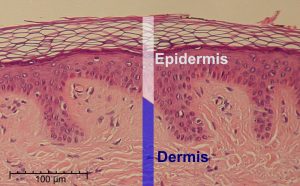The Epidermis
What is the Epidermis?
When we think of protecting our bodies from the elements, we may think of putting on a jacket, or shoes and socks. Perhaps you use sunscreen, and wear a hat and sunglasses.
Fortunately, in addition to what we wear, we also have a built-in protective covering that keeps our insides safe from our external environment. Our skin, the largest organ in our body, serves this crucial purpose with a layer known as the epidermis as our first line of defence. Let’s take a closer look at this skin layer and gain an understanding of why it is so important to our body.
Function of the Epidermis
The epidermis is the outermost layer of our skin. Tough and resilient, protection is its number one job. Think of a parka you may wear in the winter. The inside is lined with soft fleece, providing a layer of warmth. But the outside is made of a strong waterproof material that lets nothing through. It is a similar situation with our own epidermis.

Cross-Section of Skin
The protective qualities of our outer layer are vast. Our epidermis is waterproof, which is why we don’t swell with liquid each time we bathe or shower. The cellular structure of the epidermis also forms a highly effective barrier against germs. When skin is healthy and intact, it is difficult for bacteria and viruses to make an entrance.
In addition, cells of the epidermis have the miraculous ability to regenerate, or grow back, unlike many other cells in the body. When we suffer from a wound, healthy skin heals and replaces damaged cells with ease.
The epidermis is sub-divided into 5 layers.
Stratum corneum
The outermost layer of the epidermis. There are many cells which are tightly packed together, This allows the skin to be tough and waterproof. This layer is important in the prevention of invasion from foreign things, such as bugs and bacteria.
Stratum lucidum
This layer contains several clear and flat dead cells. It is a tough layer and is found in thickened skin, including the palms of the hand and soles of the feet.
Stratum granulosum
The stratum granulosum is composed of 3 to 4 layers of cells. Here, keratin is formed, which is a colourless protein important for skin strength.
Stratum spinosum
This layer contains cells that change shape from columnar to polygonal. Keratin is also produced here.
Stratum basale
This layer is the deepest layer of the epidermis, in which many cells are active and dividing. The stratum basale is separated from the next layer – the dermis – by a basement membrane, which is a layer made of collagen and proteins.
